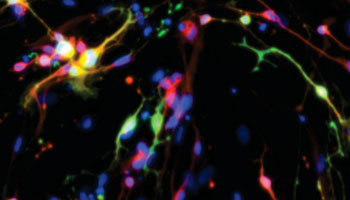Method for In Vitro Neuron Culture Will Advance Serotonin Research
By LabMedica International staff writers
Posted on 25 Aug 2015
A method has been developed that enables human serotonin-producing neurons, generated from transformed fibroblasts, to be grown in culture for use as a tool for research and drug discovery on many serotonin-related mental disorders.Posted on 25 Aug 2015
Serotonergic (5HT) neurons exert diverse and widespread functions in the brain. Malfunctions of the serotonergic system give rise to a variety of mental illnesses including depression, anxiety, obsessive compulsive disorder, autism, and eating disorders. Up to now, it has not been possible to grow cultures of human serotonin-producing neurons in the laboratory, so studies have been carried out on animals.

Image: Cells with a nucleus (labeled blue), were originally human fibroblasts, some of which have been converted to neurons that produce serotonin (green) while others have been converted to produce another neuron-specific protein. Yellows, greens, and other colors result from overlapping labels (Photo courtesy of Dr. Jian Feng, University at Buffalo).
A technological breakthrough devised by researchers at the University at Buffalo (NY, USA) has changed this picture. They demonstrated a method for directly converting human primary fibroblasts into induced serotonergic (i5HT) neurons. This was accomplished by growing fibroblasts in medium to which the genes for the proteins Ascl1 (Achaete-scute homolog 1), Foxa2 (forkhead box protein A2), Lmx1b (LIM homeobox transcription factor 1-beta), and FEV (a gene exclusively expressed in neurons of the central serotonin (5-HT) system) had been added. The transformation process was enhanced by inhibiting the gene for p53 and maintaining appropriate culture conditions including hypoxia.
Results published in the July 28, 2015, online edition of the journal Molecular Psychiatry revealed that the i5HT neurons expressed markers for mature serotonergic neurons, had calcium ion dependent 5HT release and selective 5HT uptake, exhibited spontaneous action potentials and spontaneous excitatory postsynaptic currents. Application of serotonin significantly increased the firing rate of spontaneous action potentials, demonstrating the functional utility of i5HT neurons for studying serotonergic neurotransmission.
“This research shows that it is possible to convert one type of cell into other types that have been difficult to access, such as neurons or heart cells,” said senior author Dr. Jian Feng, professor of physiology and biophysics at the University at Buffalo. “All we need to do is find out the combination of transcription factors that is necessary. Sooner or later, we will find out what those combinations are so that we can regenerate cells and eventually tissues that will mimic the real cells and tissues in the body.”
“These patient-specific serotonin neurons will be very useful to the discovery of new drugs for diseases ranging from depression and anxiety to obsessive-compulsive disorder and many others,” said Dr. Feng. “They will not only allow researchers to study why certain individuals develop a disease but also to find out what can be done to treat it.”
Related Links:
University at Buffalo














